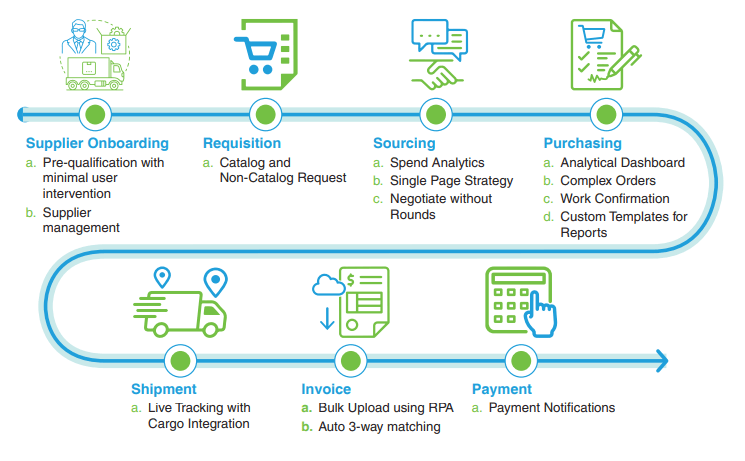More importantly, what can you do to effectively manage it?
Procurement functions in any organization across the globe are identified by its ability to conserve costs and maximize savings to purchase or procure goods and services that add or drive value for the business.
Organizations generally tend to spend less and get more value out of their purchases. This could, at times, lead to an inconsistent purchasing process, deviations from standard operating procedures, minimal assessments of processes, quick decisions that do not align with strategic objectives, and unforeseen challenges that require ad-hoc and temporary fixes. However, these situations might work favorably in the short-term, but would actually hamper overall business health in the long run with adverse impacts and dependent risks that creeps across functions.
When the source of the risks and challenges is the procurement functions, a robust and strong system for checks & balances is mandatorily required to be put in place.
Procurement risk management is a process that helps organizations identify, assess, and mitigate the potential for adverse outcomes from procurement processes. It includes identifying and understanding the risks associated with different procurement methodologies and tools, developing strategies to mitigate those risks, and monitoring and assessing the effectiveness of those strategies.
Generally, procurement risks can be caused due to one to several factors, vis-à-vis; unreliable suppliers, inaccurate assessment of internal needs, poor supplier management, non-compliance of contract management, supply-chain delays, unethical or fraudulent business practices, or even simple human errors. It becomes very daunting and tough to identify the actual cause or to take post-impact action that could help resolve the issues or reverse the adverse impacts caused by risk factors. Therefore, it is very important to manage procurement risks as it is important and necessary for the organizational bottom line and reputation. Businesses must consistently monitor risk factors impacting their current and future procurement.
One of the biggest challenges for businesses is failing to detect risks at the right time or within the right time frame to avoid major impact. One of the primary reasons is the lack of visibility and transparency in their procurement processes. Having a transparent process and yet failing to detect or address risks is a change-management or adaptability issue that can be addressed via focused training, tailoring systems to suit common business practices and procurement procedures, and streamlining the tracking and reporting methodologies within the system that align with the overall organizational culture.
Lack of transparency, on the other hand, is a more complex environment that requires more careful thought and well-proven methodologies and strategies to be implemented within the organizational behavior and system workflows. Some of the key methods to adopt more organized and transparent procurement practices include:
-
Standardize procurement processes
-
Automate tedious procurement tasks
-
Nurture client relationships
-
Leverage e-procurement solutions
-
Invest in a digital adoption platform to support your procurement digitalization
-
Prioritize clear communication
-
Track supplier performance
With these methods, it becomes fairly easier to build a strong plan to assess, monitor and address procurement risk factors. Of course, that would still need to identify the likely procurement risks and use them as a framework for reference to build a risk management strategy and plan. Businesses need to familiarize themselves with the procurement risks commonly faced. These include:
-
Inaccurate internal needs analysis
-
Poor vendor sourcing
-
Ineffective supplier and vendor onboarding
-
Inadequate vendor management
-
Price instability
-
Resistance to digitalization leading to poor e-procurement adoption
-
Manual procurement processes
-
Inaccurate forecasting
-
Compliance management
-
Budget overspend
-
Supply chain disruptions
-
Talent shortage
-
Inefficient contract management
While building a procurement risk management plan, it is very important to consider a system that will help align with these objectives. The system should work well with the organizational plans for procurement risk management and should complement the overall goal and objective. Only then will the desired benefits be realized and outcomes achieved.
ELIT procurement productivity suite is a one-stop solution for all your business risk management needs. ELIT fuses supply chain acumen with a deep understanding of industry-centered procurement practices, echoing its robust sourcing and procurement capabilities and benefits.
With ELIT P2P businesses can rely on a scalable, flexible, and robust system that will cater to end-to-end procure-to-pay lifecycle. This enables a seamless and unified system capable of addressing risks and gaps across supplier onboarding, supplier management, purchase requisitions, sourcing and evaluations, supplier collaborations and performances, supplier orders and invoicing, and over all audit and regulatory track and monitoring.
ELIT offers the enviable capability to seamlessly adapt to organizational processes across any industry and existing system landscape and facilitate a simple, customizable, lightweight, and effective process-oriented procurement risk management system.

To know more about how ELIT can benefit your business, log in to elit.ai or email info@eit.ai for a representative to get in touch with you.
You can also download ELIT brochure here
INTERESTED TO KNOW MORE?
CLICK THE BELOW BUTTON TO SCHEDULE A DEMO WITH US!





